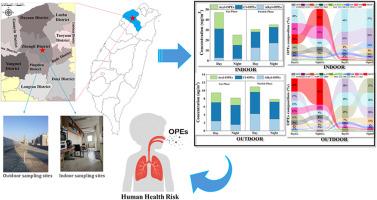城市环境中大气有机磷酯:季节趋势、日变化和风险评估
IF 3.7
2区 环境科学与生态学
Q2 ENVIRONMENTAL SCIENCES
引用次数: 0
摘要
有机磷酸酯(OPEs)是一种广泛存在的环境污染物,主要用作阻燃剂和增塑剂,但人们对它们的命运知之甚少。本研究全面检查了城市环境中室内外空气中的OPEs,重点关注浓度、季节模式和健康风险。在为期一年的采样活动中,研究人员分析了17种OPEs,包括芳基、烷基和氯化类型的细颗粒物(PM2.5)和气相。室外气相OPE浓度范围为0.04 ~ 2.68 ng/m3,颗粒物浓度范围为0.07 ~ 0.49 ng/m3。室内气相浓度较高,为0.13 ~ 7.84 ng/m3,颗粒物浓度为0.08 ~ 1.26 ng/m3。气相中以氯化OPEs为主,颗粒相中以烷基OPEs为主。季节变化表明,春季和夏季OPE水平升高,主要归因于挥发性增加和海源气团,而冬季浓度最低,偶尔与来自中国东北的远程输送有关。日间测量表明,室内气相OPE浓度在白天较高,与人类活动增加和室内温度升高相一致。主成分分析表明,当地工业排放和东南亚和东北地区的区域运输是主要污染源。儿童的估计每日摄入量(EDI)值超过成人,表明更容易受到伤害。然而,两组的危害商(HQ)值仍然低于1,这意味着低的非致癌性吸入风险。这些发现强调了继续监测和控制OPEs来源的重要性,特别是在人类接触最明显的室内环境中。本文章由计算机程序翻译,如有差异,请以英文原文为准。

Atmospheric organophosphate esters in the urban environment: Seasonal trend, diurnal variation, and risk assessment
Organophosphate esters (OPEs) are widespread environmental contaminants used primarily as flame retardants and plasticizers, yet their fate remains poorly understood. This study comprehensively examined OPEs in indoor and outdoor air in urban environments, focusing on concentrations, seasonal patterns, and health risks. Seventeen OPEs, including aryl, alkyl, and chlorinated types, were analyzed in fine particulate matter (PM2.5) and the gas phase over a year-long sampling campaign. Outdoor gas phase OPE concentrations ranged from 0.04 to 2.68 ng/m3, while particulate concentrations varied from 0.07 to 0.49 ng/m3. Indoor gas phase concentrations were higher, ranging from 0.13 to 7.84 ng/m3, and particulate concentrations from 0.08 to 1.26 ng/m3. Chlorinated OPEs dominated the gas phase, whereas alkyl OPEs were more prevalent in the particulate phase. Seasonal variations revealed elevated OPE levels in spring and summer, attributed primarily to increased volatilization and marine-derived air masses, whereas winter concentrations were the lowest and occasionally linked to long-range transport from northeastern China. Diurnal measurements indicated that indoor gas phase OPE concentrations were higher during daytime, coinciding with increased human activities and elevated indoor temperatures. Principal component analysis suggested local industrial emissions and regional transport from Southeast Asia and Northeast China as key sources. Estimated daily intake (EDI) values for children exceeded those for adults, indicating greater vulnerability. However, hazard quotient (HQ) values for both groups remained below unity, implying low non-carcinogenic inhalation risk. These findings highlight the importance of continued monitoring and source control of OPEs, especially in indoor environments where human exposure is most pronounced.
求助全文
通过发布文献求助,成功后即可免费获取论文全文。
去求助
来源期刊

Atmospheric Environment
环境科学-环境科学
CiteScore
9.40
自引率
8.00%
发文量
458
审稿时长
53 days
期刊介绍:
Atmospheric Environment has an open access mirror journal Atmospheric Environment: X, sharing the same aims and scope, editorial team, submission system and rigorous peer review.
Atmospheric Environment is the international journal for scientists in different disciplines related to atmospheric composition and its impacts. The journal publishes scientific articles with atmospheric relevance of emissions and depositions of gaseous and particulate compounds, chemical processes and physical effects in the atmosphere, as well as impacts of the changing atmospheric composition on human health, air quality, climate change, and ecosystems.
 求助内容:
求助内容: 应助结果提醒方式:
应助结果提醒方式:


